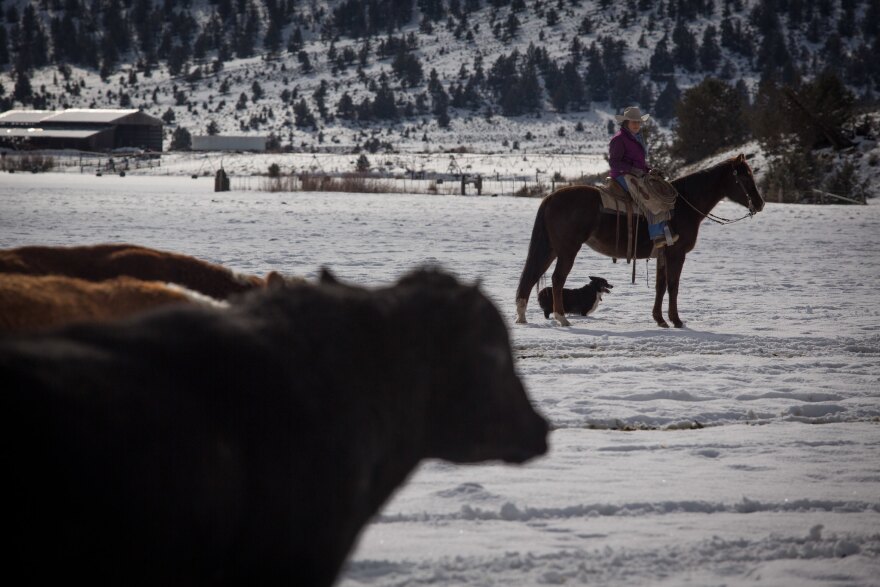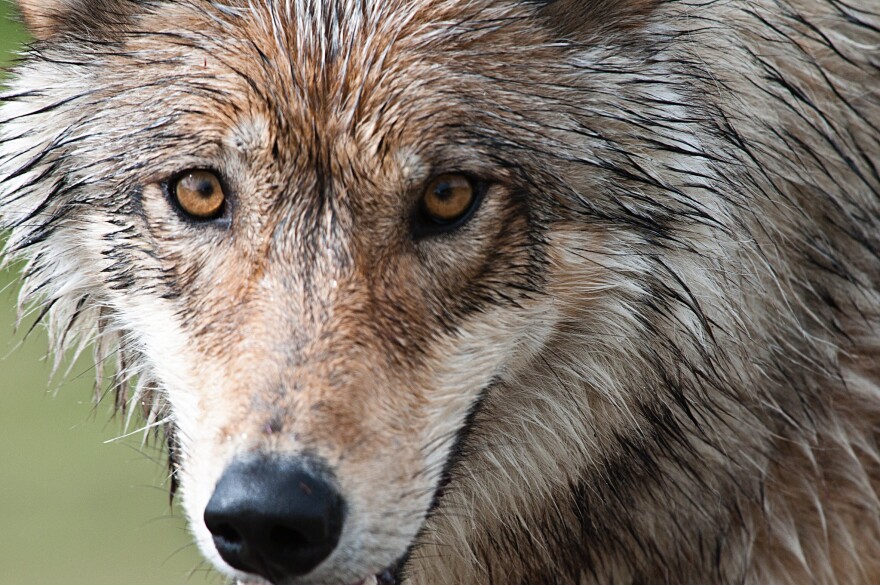Some ranchers are saying it is time to find creative ways to deal with wolf attacks on livestock. That’s what a new bill in the Washington state Senate hopes to do – to the frustration of some wildlife rights groups.
A big goal of Senate Bill 5939 is to lethally remove wolves that chronically attack livestock. Right now, ranchers say, current methods – with all the paperwork and decisions – are like disciplining your pet, days later. The wolves don’t understand why they are being targeted.
“I think if people listen to what’s being proposed, they will find goodness whether you like wolves or you don’t like wolves,” said bill sponsor Keith Wagoner, R-Sedro-Woolley, during a public hearing Thursday.
The bill would create a three-year pilot program where ranchers can kill the first wolf to return to where the livestock was killed. It’s unclear if that means livestock carcasses, which can attract wolves, would be left in the area or not.
“We would rather go after the culprit early in the game and then not try and get the cousins, aunts and uncles that come in for a dinner later, because they all have to eat. We understand that. They don’t know the difference,” livestock producer Jeff Dawson said.
Going after the culprit early also would help prevent more livestock from getting attacked, said rancher Samee Charriere, who is on the state’s Wolf Advisory Group (WAG). Charriere spoke via Zoom from inside her tractor, saying she was about to feed her cattle after she testified.
“These cattle are our livelihood,” she said. “It’s very emotional and it’s very much an economic loss to us to be continuing to have these depredations.”

Non-lethal defenses
While bill opponents said they sympathized with ranchers and appreciated attempts at finding creative solutions, they explained that they worried the first wolf to return to a kill site might not be the one that killed the animal.
“We think this bill undermines the efforts that have gone into ensuring robust, proactive, non-lethal efforts are deployed as the first and best defense against loss of livestock,” Paula Swedeen, senior policy director with Conservation Northwest and a member of WAG.
WAG’s wolf protocol is the reason the state is having “unprecedented success” minimizing wolf-livestock conflict compared to other states, said Dan Paul, Washington state director of the Humane Society of the United States and a member of WAG.
Last year, he said, with at least 216 wolves on the landscape and more than 200,000 cattle, there were 15 confirmed wolf depredations on cattle.
“Wolf-livestock conflict is the most challenging of wildlife topics that our state faces,” Paul said.
Protecting versus baiting
The state Department of Fish and Wildlife also raised concerns about language in the bill. Julia Smith, Endangered Species Recovery section manager with the department, asked for clarification on how the three-year program would be implemented.
She said it’s also unclear whether livestock carcasses could be left out at the depredation site, which would be a violation of state law that “prohibits negligent or initial feeding or attraction of carnivores.” Removing livestock carcasses is a “cornerstone” of mitigating conflict between wolves and livestock, Smith said.
“There is a thin line between a livestock producer protecting livestock and hunting wolves over bait,” Smith said.
Inslee asks for new lethal removal rules
While the state legislature looked for “out of the box” solutions to deal with depredations and lethal removal of wolves, Gov. Jay Inslee last week also ordered the state to figure out new rules for when it kills wolves that repeatedly attack livestock.
The order effectively reverses a decision by the state Fish and Wildlife Commission, which had denied a similar petition in October by wildlife advocacy groups.
The groups, including Washington Wildlife First and the Center for Biological Diversity, had raised concerns about how the state determines when wolves should be killed.
“My concern from the beginning has been that there has been no disciplined, science-based, accountable process for making those decisions,” said Claire Loebs-Davis, president and acting director of Washington Wildlife First.
In a letter to the groups, Inslee wrote that he cannot prescribe new rules. However, he said he would like the state Department of Fish and Wildlife to consider adopting a rule that officially includes WAG’s policies for lethally removing wolves that cause conflicts.
“I appreciate that the Director has utilized the protocol in his decision-making regarding lethal removal. Putting the protocol into rule or policy would provide consistency, continuity, and confidence for future administrations,” Inslee wrote.
But, Loebs-Davis said the protocols are “ad hoc, heavily influenced by politics and pressure from special interests.”
OPT Pack controversy
In public records requests and litigation documents, she said Washington Wildlife First learned the lethal removal decisions don’t always follow protocol set by WAG.
For example, she said, when the department authorized lethal removal of the Old Profanity Territory, or OPT, pack in 2019, it stated the livestock owner had used other non-lethal means to protect their herd.
“When we looked at the internal documents that led to that decision, it was clear that the department biologist just did not think that was the case,” she said. “They acknowledged that there was no range riding, that the livestock producer had prevented department range riders from protecting its cattle.”
According to department leaders, these decisions happen on a case-by-case basis.
“The current protocol was developed through an extensive process and provides the flexibility to tailor the department's response to each specific scenario; considering the recent history of the pack, the nonlethal prevention measures used by the affected livestock producers, and any other pertinent considerations,” department spokesperson Staci Lehman wrote in an emailed statement.

Rancher buy-in
In a blog post, Conservation Northwest’s senior policy director Paula Swedeen said it previously opposed the petition to formalize lethal removal regulations, writing that Washington has the most rancher buy-in for non-lethal measures, which Swedeen said amounts to the lowest depredation and fewest lethal removals in the region.
“On the ground, there would be more resentment, less conflict deterrence effort, and, worst of all, more dead wolves,” Swedeen wrote.
In 2019, Inslee called on the state to “significantly reduce” wolf kills.
“We must find new methods to better support the coexistence between Washington’s livestock industry and gray wolves in our state. The status quo of annual lethal removal is simply unacceptable,” Inslee wrote at that time.
Since then, Lehman said the department has “demonstrably reduced lethal removals of wolves,” with no lethal removals of entire wolf packs, and no lethal removals of any wolves in the Kettle Range, which is a known area of high wolf activity.
This most recent directive marks the third time Inslee has asked the commission to review its wolf policies.
In a news release, the department said it will “comply with the directive and staff will meet with the Washington Fish and Wildlife Commission regarding the timing and process for initiating rule making.”
‘Caught in the act’ rules
In his most recent letter, Islee also wrote that he would like the state commission to reconsider “caught in the act rules,” saying “a number of wolves” have been killed recently, even when they weren’t actively attacking livestock.
“If not restricted and carefully monitored, this vague policy may be used to unjustly kill an increasing number of Washington’s wolves,” Inslee wrote.
According to the department’s news release, the commission and the governor have both denied similar requests from wildlife advocates in the past. The commission denied similar petitions in 2014, 2020, 2022 and 2023, and Inslee denied the petition in 2014.
The department said it has reduced lethal removals by an average of 64% over the last four years, killing nine wolves in 2019, three in 2020, two in 2021, six in 2022 and two in 2023.
Right now, wolves are federally protected in the western two-thirds of Washington and protected under state endangered species laws in the eastern third of the state.
“Washington has a chance to be a leader in gray wolf management,” Loebs-Davis said.
CORRECTION 1/19/24: An earlier version of this story misstated the bill number. It's Senate Bill 5939.
Copyright 2024 Northwest News Network. To see more, visit Northwest News Network. 9(MDAyNTQ1NzQ1MDEyMjk0OTcxNTI4MzljZQ001))






